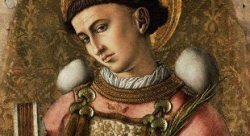
Walking With a Joyful Spirit
By Michael E. Ruane
Washington Post Staff Writer
Tuesday, December 25, 2007
In the dark of the early morning, a Roman Catholic nun in a brown tunic and black veil stepped from her cabin and walked to a nearby bell tower.
She rang two bells, calling her sisters to Christmas Eve prayer. Across the complex, other nuns emerged from their hermitages in the woods and gathered in a small chapel. From there, the 10 women embarked on a procession along pathways lit by the full moon, singing as they walked:
Sisters, Arise! Away with your sadness,
With love your hearts adorn;
All the Earth is full of gladness
Slumber not this happy morn.
By Michael E. Ruane
Washington Post Staff Writer
Tuesday, December 25, 2007
In the dark of the early morning, a Roman Catholic nun in a brown tunic and black veil stepped from her cabin and walked to a nearby bell tower.
She rang two bells, calling her sisters to Christmas Eve prayer. Across the complex, other nuns emerged from their hermitages in the woods and gathered in a small chapel. From there, the 10 women embarked on a procession along pathways lit by the full moon, singing as they walked:
Sisters, Arise! Away with your sadness,
With love your hearts adorn;
All the Earth is full of gladness
Slumber not this happy morn.

The celebration of Christmas at Charles County's historic Carmelite monastery early yesterday began in cloistered quiet, behind a tall plank fence off a back road, two miles from Crain Highway and the glitz and malls and madness of the outside world.
It was marked with boughs of evergreen and holly cut from the woods, and arranged in the prayer corners of the sisters' wooden dwellings. It was celebrated with the song of women who have given their lives to prayer and seclusion. And it was observed with a reverence for the central theme of Christianity: that with the birth of Jesus, God became man.
It's "astonishing," one said. Why would God do that?
As the Washington region awoke yesterday to a final day of shopping, travel and preparation, the Carmelites rose before dawn to bring to a close the season of Advent, ending the period of joyful longing, as they put it.
Heaven's treasure let us crave, they sang as they walked through their 65-acre compound.
Him for whom our souls are yearning
Who comes all to bless and save.
The monastery, outside La Plata, traces its history to 1790. The sisters live in a fenced-in area within the complex. They often work alone in their small, one-story individual hermitages, which contain a bedroom, bathroom, workroom and back porch. They work as artists and seamstresses. One is a weaver. They make crafts for their gift shop, which has no clerk and runs on the honor system, and they also do clerical work to help support themselves.
The nuns gather as a group to eat and pray and rarely venture beyond the fence, let alone the compound. The goal is separation from the outside world.
The prioress, Mother Virginia Marie, 73, is the only one who regularly goes outside the enclosed area within the monastery. The grounds also have a public chapel and landscaped visitor area, just beyond the fence.
"It's wholly symbolic, our separation from the world," said Mother Virginia, who was Jane O'Connor of Tulsa before she joined the Carmelite order at age 17. "We've chosen this. We're not in prison."
The aim "is to do more intently what we have chosen to do," she said in an interview last week. "So that we don't have distractions. So we can pray better. So that we can concentrate on the Lord.

"It's a life totally dedicated to God," she said. "And we can do it best when we are free from many things. . . . Silence and solitude are very conducive to prayer, and prayer is what our life is all about."
The nuns come from many walks of life. One had been a Washington lawyer, Mother Virginia said. Another worked as a physical therapist, another a federal government employee.
"I had everything life could offer," said Sister Marie Bernardina, who grew up in Bowie and worked for the government before she came to the monastery 17 years ago. "I had money. I had friends. . . . I had a car. I had boyfriends. I just wasn't happy. I had a good job. I had no debts. I just was searching for more meaning in my life."
She is 42 now. Others in the monastery range in age from 27 to 80. There are 11 in all. They come from Japan, Puerto Rico, the Philippines and across the continental United States.
Their hands look slightly gnarled from work. And they are proud of their traditional clothing, or habits, which many nuns no longer wear.
They have a car, a TV -- which Mother Virginia said is seldom watched -- and a Web site.
And they celebrate a secluded and intense kind of Christmas.
"I don't think I could ever have Christmas out there again," said Sister Clare Joseph, 45, the former physical therapist from Missouri who came to the monastery eight years ago. "It's very solemn here. We kind of curtail our contact with people [prior to Christmas]. We don't write as much. We don't receive as much mail, phone calls.
"When we do have to go out, like for dentists or that sort of thing, I find it to be just a madhouse. And I can't wait to get back here," she said.
"I love Advent. It's a time to really deepen my relationship with God," she said last week as she sat behind the decorative metal bars in the monastery's reception room, clad in her habit and a gray cardigan.
Sister Marie Bernardina said: "Advent is really a time of longing. It's a longing for something more: What is our life all about? Where are we going as a human being when we die? What is the purpose of our life?
"All these things . . . float to the surface of our consciousness when we're preparing for Christmas," she said. "It awakens our longing for Christ. . . . It's a time of joyful waiting."
In the Christmas Eve procession, which Mother Virginia described yesterday, the group visited each nun's cabin. Each door was opened as a sign of welcome to Mary and Joseph, symbolized with small statues carried by the sisters. In the New Testament story, the traveling couple seek lodging in vain and Jesus is born in a stable.
"It might sound kind of goofy to people out there," said Sister Clare Joseph. "But it's symbolic of Christ coming to me. . . . It's a real beautiful thing."
The sisters visited other sites in the complex, singing as they went, then retuned to the chapel to pray. There would be more prayer and song as the day went on, and Mass scheduled for midnight.
Today, they said, they will gather for breakfast, exchange gifts and celebrate around their tree.
But all far removed from Christmas in the outside world.
"I feel we've gone way astray" on Christmas, Sister Clare Joseph said. "There's such consumerism in our society. Consumerism leads to . . . individualism, teaches our kids [to] demand and 'have to have this,' and 'I have to have this latest electronic,' and it's just a total rat race on where the thoughts are."
"I just want to tell people, 'Don't you realize God became a man? Do you realize how astonishing that is?' " she said. "I don't think people even think about that. . . . They're so intent on decorating their homes, and buying the latest, and giving more and better and prettier gifts, and then, on the flip side, wanting more and better and prettier gifts."
"And God became man!" she said. "Why? . . . Because He loves us so much. And I think that that is totally not in most people's purview at all . . . in our society."
Yesterday, as they ended their procession on the moonlit Christmas Eve morning, they sang:
Be with us in sleep and waking
Jesus, Mary, Joseph be
Ours in life and ours when dying
Ours for all eternity.

























3 comments:
We have Christmas out here because they call Christ to us in their deep prayer life. Anyone can participate as a Lay Carmelite if they feel the calling as a vocation. This gives us the opportunity to bring Christ to others in every walk of life. We thank these sisters of Christ's love who worship Him in the Holy Mountain.
Does anyone know how the Carmelite Nuns are doing as an order? I mean, are they attracting novices? I think the Carmelites are wonderful and pray they remain a vibrant order.
Yes, the Discalced Carmelites Nuns are doing well and receiving many vocations, at least from my persepective -- as I know many within the last few years who have entered, and will be entering one this year too.
Generally, in the US the Carmels that are receiving the most vocations are the more traditional ones like the Carmel of Jesus Mary & Joseph in Valparaiso, NE -- which is overflowing with young women.
The Discalced Carmelite Nuns (OCD), reformed by Sts Teresa & John of the Cross, currently have 2 different Constitutions approved by the Holy See after Vatican II. The Constitutions approved December 8, 1990 are the original Constitutions of 1581, updated according to the directives of VII, while the Constitutions approved September 17, 1991 are the newer Constitutions. I believe it's something like 18 out of 64 Carmels in the US that are under the 1990s. Many of the Carmels under the 1991s are very traditional, but generally speaking, the 1990 Carmels are more traditional than the 1991s. They are both nevertheless united as Discalced Carmelite Nuns under the same Primitive Carmelite Rule and with Sts Teresa and John as their Spiritual Parents and Founders.
Then there are the Carmelite Nuns of the Ancient Observance (O.Carm.), who are not the reformed branch as the discalced are, but as I've heard said - some of the O. Carm. Carmels are more discalced than some of the Discalced Carmels. There are a few O.Carm. Nuns' monasteries in the US, which I believe are also doing well with vocations.
Post a Comment